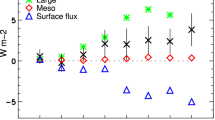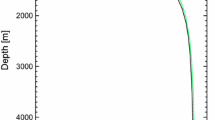Abstract
Because of significant uncertainty in the behavior of the climate system, evaluations of the possible impact of an increase in greenhouse gas concentrations in the atmosphere require a large number of long-term climate simulations. Studies of this kind are impossible to carry out with coupled atmosphere ocean general circulation models (AOGCMs) because of their tremendous computer resource requirements. Here we describe a two dimensional (zonally averaged) atmospheric model coupled with a diffusive ocean model developed for use in the integrated framework of the Massachusetts Institute of Technology (MIT) Joint Program on the Science and Policy of Global Change. The 2-D model has been developed from the Goddard Institute for Space Studies (GISS) GCM and includes parametrizations of all the main physical processes. This allows it to reproduce many of the nonlinear interactions occurring in simulations with GCMs. Comparisons of the results of present-day climate simulations with observations show that the model reasonably reproduces the main features of the zonally averaged atmospheric structure and circulation. The model’s sensitivity can be varied by changing the magnitude of an inserted additional cloud feedback. Equilibrium responses of different versions of the 2-D model to an instantaneous doubling of atmospheric CO2 are compared with results of similar simulations with different AGCMs. It is shown that the additional cloud feedback does not lead to any physically inconsistent results. On the contrary, changes in climate variables such as precipitation and evaporation, and their dependencies on surface warming produced by different versions of the MIT 2-D model are similar to those shown by GCMs. By choosing appropriate values of the deep ocean diffusion coefficients, the transient behavior of different AOGCMs can be matched in simulations with the 2-D model, with a unique choice of diffusion coefficients allowing one to match the performance of a given AOGCM for a variety of transient forcing scenarios. Both surface warming and sea level rise due to thermal expansion of the deep ocean in response to a gradually increasing forcing are reasonably reproduced on time scales of 100–150 y. However a wide range of diffusion coefficients is needed to match the behavior of different AOGCMs. We use results of simulations with the 2-D model to show that the impact on climate change of the implied uncertainty in the rate of heat penetration into the deep ocean is comparable with that of other significant uncertainties.
Similar content being viewed by others
Author information
Authors and Affiliations
Additional information
Received: 10 March 1997 / Accepted: 20 October 1997
Rights and permissions
About this article
Cite this article
Sokolov, A., Stone, P. A flexible climate model for use in integrated assessments. Climate Dynamics 14, 291–303 (1998). https://doi.org/10.1007/s003820050224
Issue Date:
DOI: https://doi.org/10.1007/s003820050224




